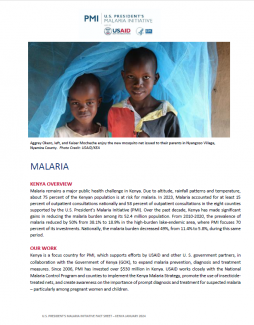MALARIA
KENYA OVERVIEW
Malaria remains a major public health challenge in Kenya. Due to altitude, rainfall patterns and temperature, about 75 percent of the Kenyan population is at risk for malaria. In 2023, Malaria accounted for at least 15 percent of outpatient consultations nationally and 58 percent of outpatient consultations in the eight counties supported by the U.S. President’s Malaria Initiative (PMI). Over the past decade, Kenya has made significant gains in reducing the malaria burden among its 52.4 million population. From 2010-2020, the prevalence of malaria reduced by 50% from 38.1% to 18.9% in the high-burden lake-endemic area, where PMI focuses 70 percent of its investments. Nationally, the malaria burden decreased 49%, from 11.4% to 5.8%, during this same period.
OUR WORK
Kenya is a focus country for PMI, which supports efforts by USAID and other U. S. government partners, in collaboration with the Government of Kenya (GOK), to expand malaria prevention, diagnosis and treatment measures. Since 2006, PMI has invested over $530 million in Kenya. USAID works closely with the National Malaria Control Program and counties to implement the Kenya Malaria Strategy, promote the use of insecticide-treated nets, and create awareness on the importance of prompt diagnosis and treatment for suspected malaria – particularly among pregnant women and children.

